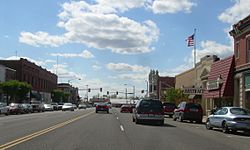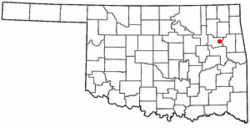Wagoner, Oklahoma facts for kids
Quick facts for kids
Wagoner, Oklahoma
|
|
|---|---|

Downtown Wagoner
|
|
| Motto(s):
" Proud Of Our Past Confident In Our Future "
|
|

Location of Wagoner, Oklahoma
|
|
| Country | United States |
| State | Oklahoma |
| County | Wagoner |
| Area | |
| • Total | 10.02 sq mi (25.94 km2) |
| • Land | 10.01 sq mi (25.93 km2) |
| • Water | 0.00 sq mi (0.01 km2) |
| Elevation | 587 ft (179 m) |
| Population
(2020)
|
|
| • Total | 7,621 |
| • Density | 760.6/sq mi (293.79/km2) |
| Time zone | UTC-6 (Central (CST)) |
| • Summer (DST) | UTC-5 (CDT) |
| ZIP codes |
74467, 74477
|
| Area code(s) | 539/918 |
Wagoner is a city in Wagoner County, Oklahoma, United States. In 2010, about 8,323 people lived there. It is the main city, or county seat, of Wagoner County. Wagoner was the first city to become officially recognized in Indian Territory on January 4, 1896.
Contents
History of Wagoner
| Historical population | |||
|---|---|---|---|
| Census | Pop. | %± | |
| 1900 | 2,372 | — | |
| 1910 | 4,018 | 69.4% | |
| 1920 | 3,436 | −14.5% | |
| 1930 | 2,994 | −12.9% | |
| 1940 | 3,535 | 18.1% | |
| 1950 | 4,395 | 24.3% | |
| 1960 | 4,469 | 1.7% | |
| 1970 | 4,959 | 11.0% | |
| 1980 | 6,191 | 24.8% | |
| 1990 | 6,894 | 11.4% | |
| 2000 | 7,669 | 11.2% | |
| 2010 | 8,323 | 8.5% | |
| 2015 (est.) | 8,713 | 4.7% | |
The city of Wagoner started as a small community. It grew where two important railroads met: the Missouri-Kansas-Texas (MKT) Railway and the Kansas and Arkansas Valley Railway. In 1887, a foreman named William McAnally built a small hotel there. Soon, more hotels and stores appeared.
The town was named after Henry "Big Foot" Wagoner. He was a railroad dispatcher who saw the need for a special railroad switch. This switch helped move logs and hay. The area was first called "Wagoner's Switch." This switch helped the town become a big center for shipping cattle.
By 1894, Wagoner had 642 residents. A local newspaper encouraged more people to move there. By 1896, the population grew to about 1,500. In late 1895, the community asked to become an official city. On January 4, 1896, Wagoner became the first city to be officially recognized in Indian Territory.
A courthouse was built in 1897. It housed a new U.S. court. The Dawes Commission changed how land was owned in Indian Territory. Land went from being owned by tribes to being owned by individuals. These individuals could sell their land, which led to a lot of farming land being sold. By the time Oklahoma became a state, Wagoner had 2,950 residents. It was chosen as the main city for Wagoner County.
The city continued to grow until 1910, when its population reached 4,018. The MKT railroad had a main office in Wagoner. The city had three major railroad lines and twenty passenger trains daily. Many businesses were there, like grain elevators, a cotton gin, and a cement plant. However, this growth slowed down in 1913. The MKT moved its main office to Muskogee. The oil boom in other areas and the Great Depression also caused Wagoner's economy and population to shrink.
World War II helped Wagoner's economy recover. The city was located between two important government projects for the war: Camp Gruber to the south and the Oklahoma Ordnance Works to the north.
After the war, several small factories started in Wagoner. In 1950, the nearby Fort Gibson Lake was finished. This helped the economy and made Wagoner a popular place for sports and retirement. A special water channel, the McLellan-Kerr channel, allowed farm products to be moved by barges. This helped farm businesses. Better highways also made Wagoner a good place to live for people who worked in Tulsa and Muskogee.
Where Wagoner Is Located
Wagoner is located at 35°57′20″N 95°22′41″W / 35.95556°N 95.37806°W. It is about 18 miles (29 km) north of Muskogee, Oklahoma. It is also about 40 miles (64 km) east of Tulsa.
According to the United States Census Bureau, the city covers about 7.0 square miles (18 km2) of land.
People in Wagoner
In 2000, there were 7,669 people living in Wagoner. There were 2,928 households and 2,111 families. The city had about 1,101 people per square mile (425/km2).
The people in Wagoner were from different backgrounds:
- 70.48% White
- 9.27% African American
- 13.21% Native American
- 0.34% Asian
- 0.08% Pacific Islander
- 0.70% from other backgrounds
- 5.92% from two or more backgrounds
About 1.93% of the people were Hispanic or Latino.
About 35.6% of households had children under 18. About 52.3% were married couples living together. The average household had 2.58 people, and the average family had 3.06 people.
The population's age groups were:
- 28.1% under 18
- 9.9% from 18 to 24
- 26.3% from 25 to 44
- 21.0% from 45 to 64
- 14.7% were 65 or older
The average age was 35 years. For every 100 females, there were about 88.7 males.
The average income for a household was $30,493. For a family, it was $35,426. About 15.5% of the population lived below the poverty line. This included 20.2% of those under 18.
News and Media
Wagoner has a local newspaper called the American-Tribune. It is published every Wednesday. In 2015, the American-Tribune was bought by BH Media. This company is part of Warren Buffett's Berkshire Hathaway.
How to Get Around Wagoner
Highways Connecting Wagoner
Wagoner is served by several main roads. These include US-69, SH-51, and SH-16. The Muskogee Turnpike (also called SH-351) offers a direct way to get to Tulsa.
Airports Near Wagoner
Hefner-Easley Airport (FAA Identifier—H68) is owned by the City of Wagoner. It is located two miles east of the city. For bigger commercial flights, people use Tulsa International Airport. This airport is about a 45-minute drive northwest.
Railroads in Wagoner
Wagoner has freight train service from the Union Pacific railroad. The city is where the old Katy and Missouri Pacific lines meet. Both of these lines are now owned by Union Pacific. Union Pacific has honored Wagoner as a "Train Town USA." This is because of the city's long and special connection with the railroad.
Famous People From Wagoner
- Bob Bogle (1934–2009), a founder of the band The Ventures.
- Isabel Cobb (1858–1947), the first woman doctor in Indian territory.
- Shelby Grant (1937–2011), an actress.
- Willis Hudlin (1906–2002), a major league baseball pitcher.
- Albert C. Hunt (1888–1956), a politician and attorney. He later became a Justice of the Oklahoma Supreme Court.
- Bobby Lane (born 1939), an American football player.
- Thomas Sleeper, (b. 1956) a conductor and composer.
- Malcolm Rodriguez (born 1999), an American football player.
See also
 In Spanish: Wagoner (Oklahoma) para niños
In Spanish: Wagoner (Oklahoma) para niños

